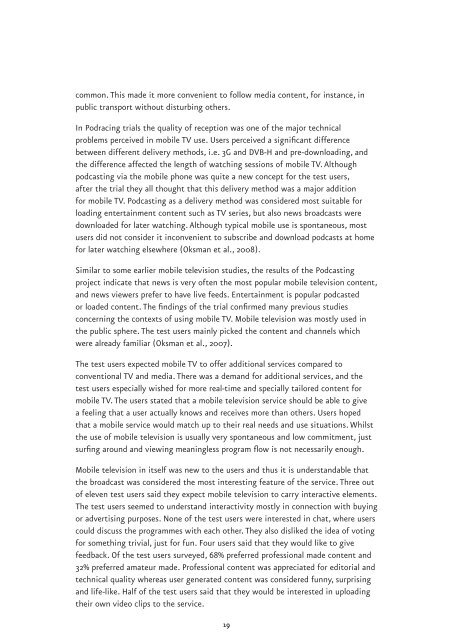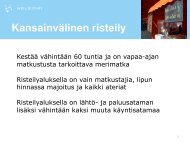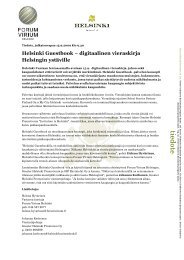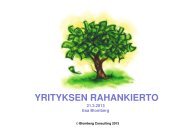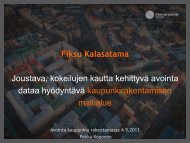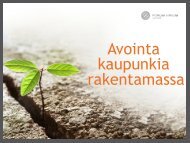FinPilot2 Final Report â User Acceptance of Mobile TV Services ...
FinPilot2 Final Report â User Acceptance of Mobile TV Services ...
FinPilot2 Final Report â User Acceptance of Mobile TV Services ...
Create successful ePaper yourself
Turn your PDF publications into a flip-book with our unique Google optimized e-Paper software.
common. This made it more convenient to follow media content, for instance, in<br />
public transport without disturbing others.<br />
In Podracing trials the quality <strong>of</strong> reception was one <strong>of</strong> the major technical<br />
problems perceived in mobile <strong>TV</strong> use. <strong>User</strong>s perceived a significant difference<br />
between different delivery methods, i.e. 3G and DVB-H and pre-downloading, and<br />
the difference affected the length <strong>of</strong> watching sessions <strong>of</strong> mobile <strong>TV</strong>. Although<br />
podcasting via the mobile phone was quite a new concept for the test users,<br />
after the trial they all thought that this delivery method was a major addition<br />
for mobile <strong>TV</strong>. Podcasting as a delivery method was considered most suitable for<br />
loading entertainment content such as <strong>TV</strong> series, but also news broadcasts were<br />
downloaded for later watching. Although typical mobile use is spontaneous, most<br />
users did not consider it inconvenient to subscribe and download podcasts at home<br />
for later watching elsewhere (Oksman et al., 2008).<br />
Similar to some earlier mobile television studies, the results <strong>of</strong> the Podcasting<br />
project indicate that news is very <strong>of</strong>ten the most popular mobile television content,<br />
and news viewers prefer to have live feeds. Entertainment is popular podcasted<br />
or loaded content. The findings <strong>of</strong> the trial confirmed many previous studies<br />
concerning the contexts <strong>of</strong> using mobile <strong>TV</strong>. <strong>Mobile</strong> television was mostly used in<br />
the public sphere. The test users mainly picked the content and channels which<br />
were already familiar (Oksman et al., 2007).<br />
The test users expected mobile <strong>TV</strong> to <strong>of</strong>fer additional services compared to<br />
conventional <strong>TV</strong> and media. There was a demand for additional services, and the<br />
test users especially wished for more real-time and specially tailored content for<br />
mobile <strong>TV</strong>. The users stated that a mobile television service should be able to give<br />
a feeling that a user actually knows and receives more than others. <strong>User</strong>s hoped<br />
that a mobile service would match up to their real needs and use situations. Whilst<br />
the use <strong>of</strong> mobile television is usually very spontaneous and low commitment, just<br />
surfing around and viewing meaningless program flow is not necessarily enough.<br />
<strong>Mobile</strong> television in itself was new to the users and thus it is understandable that<br />
the broadcast was considered the most interesting feature <strong>of</strong> the service. Three out<br />
<strong>of</strong> eleven test users said they expect mobile television to carry interactive elements.<br />
The test users seemed to understand interactivity mostly in connection with buying<br />
or advertising purposes. None <strong>of</strong> the test users were interested in chat, where users<br />
could discuss the programmes with each other. They also disliked the idea <strong>of</strong> voting<br />
for something trivial, just for fun. Four users said that they would like to give<br />
feedback. Of the test users surveyed, 68% preferred pr<strong>of</strong>essional made content and<br />
32% preferred amateur made. Pr<strong>of</strong>essional content was appreciated for editorial and<br />
technical quality whereas user generated content was considered funny, surprising<br />
and life-like. Half <strong>of</strong> the test users said that they would be interested in uploading<br />
their own video clips to the service.<br />
19


